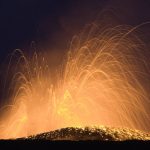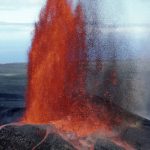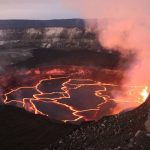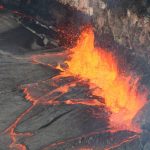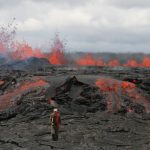With the Fourth of July just around the corner, we look forward to the long-standing traditions of Independence Day — parades, picnics and especially fireworks. The holiday hardly seems complete without a brilliant display of pyrotechnics as its grand finale.
With the Fourth of July just around the corner, we look forward to the long-standing traditions of Independence Day — parades, picnics and especially fireworks. The holiday hardly seems complete without a brilliant display of pyrotechnics as its grand finale. It’s fun to hear delighted spectators “ooh” and “ahh” with each boom and burst of color as exploding fireworks light the night sky.
On the Island of Hawaii, similar sounds of wonder and delight can be heard on Kilauea Volcano, which, for many years, has captivated onlookers with its own version of “fireworks.” From small flows oozing at a snail’s pace to torrents of molten rock shooting skyward, red-hot lava attracts crowds of enthralled observers, like moths to a flame.
So, with the Fourth of July serving as inspiration, this week’s Volcano Watch is a photo essay featuring notable images from Kilauea Volcano’s two ongoing eruptions: East Rift Zone (Puu Oo), which began in 1983, and summit (Halemaumau), which began in 2008.
Kilauea has been erupting nearly non-stop for the past 34-plus years. But those years have been punctuated with stunning and dramatic eruptive events that rival the island’s best fireworks shows. Examples include the episodic high lava fountains erupted during the first few years of the Puu Oo eruption and the spectacular fireworks-like displays of incandescent spatter from the explosive interaction of lava and seawater at ocean entries.
Have a safe and happy July Fourth holiday — and enjoy these fiery images of Kilauea. More eruption photos are available on the USGS Hawaiian Volcano Observatory website: https://volcanoes.usgs.gov/volcanoes/kilauea/multimedia_chronology.html.
Volcano Watch (https://hvo.wr.usgs.gov/volcanowatch/) is a weekly article and activity update written by U.S. Geological Survey Hawaiian Volcano Observatory scientists.
Volcano Activity Updates
This past week, Kilauea Volcano’s summit lava lake fluctuated in concert with summit inflation and deflation, with levels ranging 28–52 m (92–171 ft) below the vent rim. On the East Rift Zone, the 61g flow remained active, with lava entering the ocean near Kamokuna. Near Puu Oo, flows continued on the upper portion of the flow field. The 61g flows do not pose an immediate threat to nearby communities.
Mauna Loa is not erupting. During the past week, only a few small-magnitude earthquakes occurred beneath the volcano, primarily in the south caldera and upper Southwest Rift Zone at depths less than 5 km (3 mi). A few earthquakes also occurred on the west flank of the volcano at depths of 0–13 km (0–8 mi). Global Positioning System (GPS) and Interferometric Satellite Radar (InSAR) measurements continue to show deformation related to inflation of a magma reservoir beneath the summit and upper Southwest Rift Zone. No significant changes in volcanic gas emissions were measured.
Two earthquakes were reported felt on the Island of Hawaii during the past week. On June 28, at 6:58 p.m. HST, an offshore magnitude-2.5 earthquake occurred near the submarine volcano Loihi, 42 km (26 mi) southeast of Pahala, at a depth of 12.5 km (7.8 mi). On June 26, at 11:27 p.m. HST, a magnitude-2.4 earthquake occurred 4 km (2.5 mi) southeast of Leilani Estates at 1 km (0.6 mi) depth.
Please visit the HVO website (https://volcanoes.usgs.gov/hvo) for past Volcano Watch articles, Klauea daily eruption updates, Mauna Loa weekly updates, volcano photos, recent earthquakes info, and more. Call for summary updates at 967-8862 (Kīlauea) or 967-8866 (Mauna Loa). Email questions to askHVO@usgs.gov.
